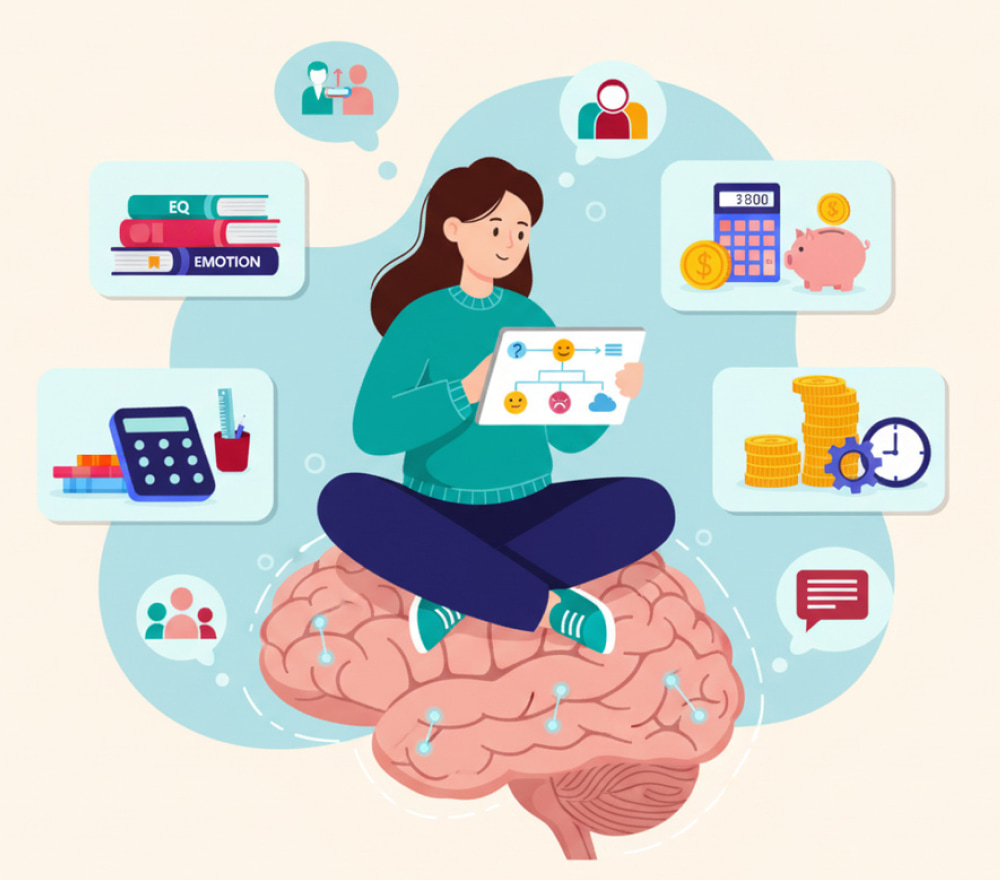The Ultimate Guide to Measuring and Growing Your Emotional Intelligence

Take EQ (Emotional Intelligence) Test
Start the TestWhat Emotional Intelligence Really Measures
Emotional intelligence describes how effectively you perceive, understand, use, and regulate emotions in yourself and in others. Rather than a single trait, it functions as a constellation of abilities that influence composure under stress, clarity in conflict, and depth in collaboration. When individuals develop these capabilities, they tend to make wiser choices, de-escalate tensions faster, and cultivate more resilient relationships across personal and professional domains.
Modern assessments aim to capture both the knowledge and the behaviors that animate these skills in real life. In this context, the EQ emotional intelligence test operates like a diagnostic dashboard that translates subtle patterns into scores you can interpret and apply. By combining reflective questions with situational judgment items, these tools illuminate strengths and blind spots you might otherwise miss.
- Self-awareness: recognizing triggers, values, and inner narratives that shape reactions.
- Self-management: sustaining focus, delaying impulses, and adapting to change with flexibility.
- Social awareness: reading cues, empathizing across differences, and sensing group climate.
- Relationship management: influencing constructively, resolving friction, and building trust.
Because emotions color attention, memory, and decision-making, higher competency often correlates with improved teamwork, customer satisfaction, and leadership effectiveness. These are not static qualities; with intentional practice and feedback, your emotional skills can grow substantially over time.
Why Taking an EQ Assessment Matters for Careers and Relationships
Organizations increasingly prize emotional agility because it lifts culture and performance simultaneously. Hiring managers screen for composure, empathy, and collaboration under pressure, while leaders rely on these capacities to inspire commitment and navigate ambiguity. Individuals who invest in evaluating their interpersonal style gain a tactical edge in negotiations, mentorship, and cross-functional projects where nuanced communication determines outcomes.
For many professionals, the EQ intelligence test functions as a catalyst for targeted development, turning vague self-impressions into practical goals you can train toward. This kind of clarity prevents wasted effort and shortens the path from insight to daily habit. With concrete benchmarks, you can measure progress and calibrate strategies as responsibilities evolve.
- Pinpoint emotional triggers so you can prepare scripts and grounding techniques in advance.
- Translate feedback into micro-behaviors, such as pausing before replying or asking clarifying questions.
- Track situational patterns to refine how you respond to different teammates and contexts.
- Demonstrate leadership potential by aligning empathy with accountability and results.
In relationships at home, these same abilities foster patience, curiosity, and vulnerability, which reinforce intimacy and mutual respect. Progress compounds when you combine assessment-driven insights with deliberate practice and accountability partners who reflect your growth honestly.
How These Assessments Work: Domains, Formats, and Timing
EQ assessments typically blend self-report scales, ability-based tasks, and occasionally multi-rater feedback to yield a rounded profile. Each format offers trade-offs: self-report is efficient but can be biased, ability tasks are harder to game but require more time, and 360s capture impact across stakeholders yet depend on rater availability. Selecting the right format depends on your purpose, whether it’s personal reflection, leadership development, or enterprise-level talent planning.
When used thoughtfully, the emotional intelligence EQ test harmonizes subjective perception with objective indicators to surface actionable themes you can train against. That synthesis matters because emotional skill shows up differently under stress than it does in calm conditions, and robust tools account for these contextual shifts. Look for instruments that provide normative comparisons, reliability data, and recommendations mapped to specific behaviors.
| Format | Primary Strength | Best Use Case |
|---|---|---|
| Self-report questionnaire | Fast overview of perceived habits | Personal reflection and baseline screening |
| Ability-based tasks | Performance on emotion reasoning items | Objective benchmarking and skill diagnostics |
| 360-degree feedback | Observed impact across rater groups | Leadership development and succession planning |
| Gamified micro-assessments | High engagement with situational variety | FrEQuent pulse checks and learning reinforcement |
Timing also shapes validity. If you complete the measure in a rush or during an unusually stressful week, your profile may skew. Schedule a calm window, minimize interruptions, and read instructions carefully so each response reflects your typical patterns rather than an outlier moment. The result will be a clearer map of where to invest your effort next.
Smart Preparation and Honest Responses
Preparation for an EQ assessment isn’t about memorizing answers; it’s about priming your self-awareness. Before you start, reflect on recent conflicts, feedback you’ve received, and moments you handled well or poorly. These snapshots help you answer consistently and reduce the temptation to idealize your behavior. The most useful profiles are authentic, not polished for appearance.
During the process, the EQ test of emotional intelligence becomes a mirror that rewards candor rather than perfection, because accuracy accelerates growth later. Pausing briefly before each item can anchor your judgment in real examples instead of wishful thinking. If a question seems ambiguous, visualize a specific situation and imagine how you actually responded to anchor your choice.
- Choose a quiet environment and silence notifications to sustain concentration throughout.
- Skim all instructions, then pace yourself steadily to avoid careless errors and fatigue.
- Aim for consistency across similar items to reduce random noise in your results.
- Note any surprising emotions that surface; they can highlight learning edges worth exploring.
Afterward, jot down immediate reflections while the experience is fresh. Those notes will make your debrief more insightful and help you translate patterns into practical next steps that fit your routines.
Interpreting Your Results and Building an Action Plan
Scores are the beginning, not the end. Treat your report as a hypothesis that you will validate through feedback, journaling, and real-world experiments. Start by prioritizing one or two high-leverage behaviors, because focused effort beats scattershot attempts. Align these behaviors with situations you face weekly to ensure repetitions and measurable progress.
If you’re curious but not ready for a full instrument, the phrase test your emotional intelligence free EQ quiz can point you to lightweight samplers that introduce the core ideas without deep diagnostics. While brief, these tools can spark motivation and highlight themes you might investigate with more rigorous assessments later. Use any quick check as an on-ramp, not a stand-in for a comprehensive evaluation.
- Translate findings into clear, observable habits like “ask two clarifying questions before proposing solutions.”
- Build a practice loop: plan, act, reflect, and solicit feedback from a trusted colleague.
- Create cues in your calendar or workspace to prompt the behavior when it matters most.
- Review progress monthly and adjust tactics if a habit isn’t sticking or producing impact.
Finally, celebrate incremental wins to reinforce momentum. Emotional capability grows through repetition, reflection, and coaching, and your environment can either accelerate or inhibit that cycle. Design for success by making your new behaviors easy, obvious, and rewarding.
Faq: Practical Answers About EQ Testing
How long does an assessment usually take?
Most questionnaires require 10 to 30 minutes, depending on depth and format. Ability-based tasks and multi-rater options can extend the timeline because they include more items or depend on feedback from others. Plan a quiet block of time so your focus and answers remain steady from start to finish.
What makes an EQ assessment scientifically credible?
Credible instruments publish reliability and validity evidence, use representative norm groups, and offer transparent scoring logic. You should also see clear behavioral definitions for each scale and guidance for interpretation. Independent peer-reviewed research is a strong signal that the tool measures what it claims to measure.
Can I improve my scores with practice?
Yes, because emotional skills respond to training much like physical or cognitive skills do. Regular practice with feedback can strengthen self-awareness, regulation, empathy, and influence over time. For sustained gains, combine micro-habits with coaching and deliberate reflection after high-stakes conversations.
Is there a difference between knowledge and real-world behavior?
There is a meaningful gap between knowing and doing, which is why scenario-based items and feedback from others add value. A report might show strong understanding but highlight inconsistent behavior under pressure, and that contrast guides precise training. Focus your development where stress tends to disrupt your intentions most.
Which metric names should I look for in reports?
Look for clear domain breakdowns such as self-awareness, self-management, social awareness, and relationship management, along with practical coaching tips. In many contexts, the emotional intelligence quotient EQ test label appears to indicate a standardized summary that complements those subscales effectively. What matters most is actionable guidance tied to well-defined behaviors you can practice immediately.
